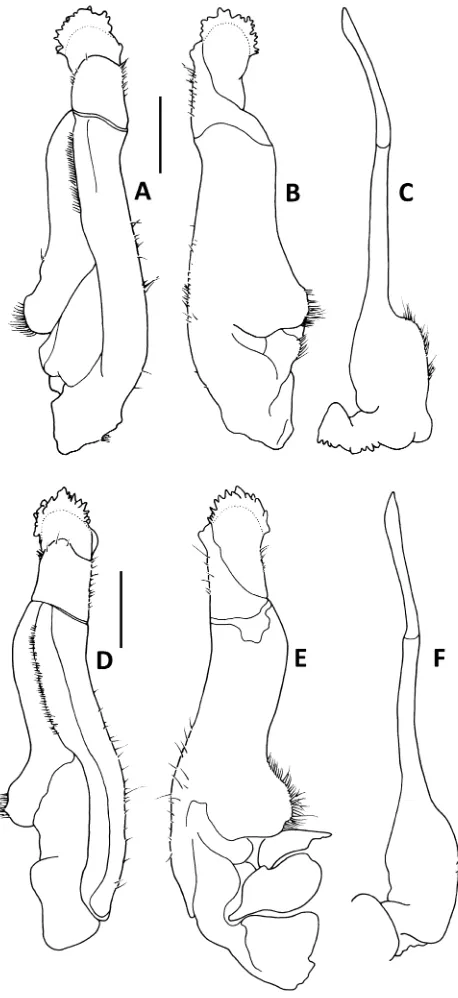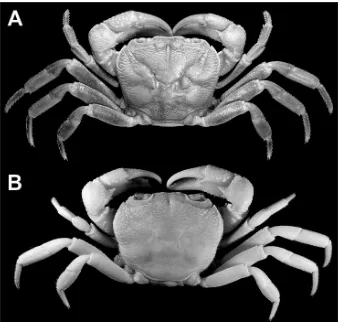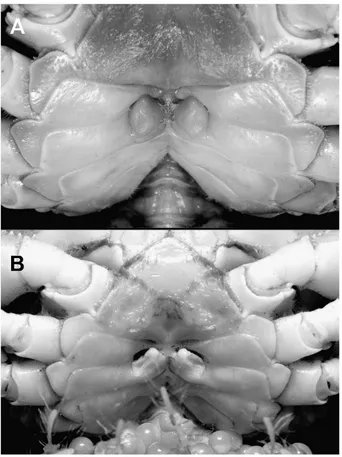(DECAPODA, BRACHYURA, POTAMIDAE) FROM GUNUNG SLAMET, CENTRAL JAVA, INDONESIA
BY
DAISY WOWOR1,3)and SWEE HEE TAN2,4)
1)Division of Zoology, Research Center for Biology, Indonesian Institute of Sciences (LIPI), Jalan Raya Jakarta Bogor km 46, Cibinong 16911, Indonesia
2)Raffles Museum of Biodiversity Research (RMBR), National University of Singapore, Department of Biological Sciences, 6 Science Drive 2, #03-01, Singapore 117546,
Republic of Singapore
ABSTRACT
A new species of terrestrial potamid crab, Malayopotamon lipkeisp. nov., is described from Gunung Slamet, Central Java, Indonesia. This new species is similar toM. granulatum (De Man, 1892), but can be differentiated by several characters, viz. the carapace with longer anterolateral serrated crest margins, the relatively larger and the denser granules on branchial and gastric regions, more prominent epigastric lobes, males with proportionately broadly abdominal somites III-V, more granulated chelipeds, and distal segment of G1 bent inwards at about 30◦.
RÉSUMÉ
Une nouvelle espèce de crabe terrestre Potamidae, Malayopotamon lipkei sp. nov., est décrite de Gunung Slamet, Java centrale, Indonésie. Cette nouvelle espèce est similaire à M. granulatum (De Man, 1892), mais peut s’en distinguer par plusieurs caractères tels que: la carapace avec des bords en crêtes serrulés plus longues antérieurement, les régions branchiales et gastriques relativement plus grandes et avec une plus forte densité de granules, les lobes épigastriques plus proéminents, chez les mâles les somites abdominales III-V proportionellement élargis, des pinces plus granuleuses et la partie distale du G1courbée vers l’intérieur d’environ 30◦.
3)Corresponding author; e-mail: [email protected] 4)e-mail: [email protected]
728 CRM 014 – Fransen et al. (eds.), LIPKE BIJDELEY HOLTHUIS MEMORIAL VOLUME
INTRODUCTION
Of the 10 known species ofMalayopotamon Bott, 1968 (Ng et al., 2008), only two have been reported from Java, i.e. M. granulatum(De Man, 1892) andM. javanense(Bott, 1968). Both species are only known from West Java Province thus far (De Man, 1892; Bott, 1968, 1970; Ng & Tan, 1999). They are usually montane or submontane species and are sometimes found together especially in Cibodas Botanical Garden, Cianjur Regency at 1400 m asl. The most eastern known distribution for M. granulatum is Kuningan Regency in West Java at the border with Central Java (see material examined). In this paper, a new species of Malayopotamon is described from Central Java Province.
The material examined is deposited in Museum Zoologicum Bogoriense (MZB), Research Center for Biology, Indonesian Institute of Sciences, Cibi-nong, Indonesia; and Zoological Reference Collection (ZRC), Raffles Museum of Biodiversity Research, National University of Singapore. The Indonesian terms “Sungai” abbreviated as Sg., refers to river, stream or tributary, “Gu-nung” is abbreviated as Gn. referring to mountain, “Kampung” is abbreviated as Kp. referring to village. The terminology used here follows Ng (1988) and Ng et al. (2008). The abbreviations G1 and G2 refer to the first and second male gonopods, respectively.
Fig. 1. A-C,Malayopotamon lipkeisp. nov., holotype, male (43.6×37.7 mm) (MZB Cru 2902); D-F,Malayopotamon granulatum(De Man, 1892), male (45.4×37.6 mm) (MZB Cru 2905).
730 CRM 014 – Fransen et al. (eds.), LIPKE BIJDELEY HOLTHUIS MEMORIAL VOLUME
Fig. 2. Overall views. A,Malayopotamon lipkeisp. nov., holotype, male (43.6×37.7 mm) (MZB Cru 2902); B,Malayopotamon granulatum(De Man, 1892), male (40.3×35.2 mm)
(ZRC 2008.0438).
Fig. 3. Ventral views of thoracic sternites. A,Malayopotamon lipkeisp. nov., female (60.9× 50.6 mm) (ZRC), aquarium trade, supposedly from Cilacap; B,Malayopotamon granulatum
(De Man, 1892), ovigerous female (37.7×31.9 mm) (ZRC 2000.1076).
732 CRM 014 – Fransen et al. (eds.), LIPKE BIJDELEY HOLTHUIS MEMORIAL VOLUME
convex, crested; posterolateral margins converging towards posterior carapace margin; anterolateral regions with no striae; posterolateral regions with few long but low but distinct striae; posterior carapace margin straight; anterolat-eral regions lightly striated, epibranchial tooth distinct, low, separated from external orbital tooth by shallow cleft; outer margin of external orbital tooth straight, slightly serrated; epigastric lobes distinct, granulated, not continuous with postorbital cristae; postorbital cristae prominent, sharp, continuous with base of epibranchial tooth. G1 terminal segment subquadrilateral, bent inward about 30◦with jagged anterior margin.
Description. — Carapace subquadrate, anterior half wider than posterior half; width 1.23-1.26 times length (mean = 1.25, n = 5); branchial,
gas-tric and intestinal regions relatively swollen; branchial and gasgas-tric regions densely granulated, ovate and rounded granules large; other parts of dorsal surface smooth, glabrous. Gastric regions relatively swollen, not raised above orbital region. Epigastric lobes distinct, granulated, no distinct crista, not con-tinuous with postorbital cristae; postorbital cristae prominent, concon-tinuous with base of epibranchial tooth; cervical and H-shaped gastric grooves distinct. Or-bital region narrow. Frontal margin sinuous, smooth, with medial notch, more prominent in larger specimens; supraorbital and infraorbital margins crested, crista relatively smooth. Suborbital and pterygostomial regions swollen, gran-ulated, granules low, glabrous. External orbital angle tooth small, low, triangu-lar; anterolateral margin convex laterally, low crista present, smooth, serrated crest margin reach widest part of carapace; epibranchial tooth low but present. Epistome concave laterally, with median triangular lobe. Cornea of eye about same length as eyestalk, slight constriction present at junction of cornea and eyestalk. Third maxilliped rectangular; ischium with shallow median groove, length about 4 times merus width; lateral margin of merus slightly projected medially; exopod reaching to about one-third length of merus, with well de-veloped flagellum, about half width of merus.
Cheliped asymmetrical, outer surfaces with smooth low tubercles; carpus with sharp spine on inner margin, a low basal tubercle usually present below spine; merus with 2 rows of ventral cristae, outer margin more strongly tuberculated than inner. Fingers slightly longer than palm in larger male specimens.
Thoracic sternites II-IV smooth, with a few short setae. Thoracic sternites II-III and III-IV demarcated by shallow grooves. Penis coxal. Female gonopore crescent-shaped. Male abdomen with 6 free somites and telson, broadly triangular; telson triangular, lateral margins with slight medial notch.
G1 stout, distal part of terminal segment subquadrilateral, bent inwards about 30◦ with jagged anterior margin. G2 relatively long, well developed
distal segment, about two-thirds length of basal segment.
Life colour. — Carapace and ambulatory legs are reddish–purplish brown, with the chelipeds reddish light brown.
Ecological notes. — The specimens were collected from middle part of Gunung Slamet from 670 to 780 m asl. They were found under large rocks on sandy substrate, in the middle of streams with clear fast running water. The streams pass through rice fields with no canopy cover.
Etymology. — This new specific name is dedicated to the late Prof. Lipke B. Holthuis, a carcinologist of great skill, knowledge and experience. He has contributed so much to the knowledge of both authors, for which we are very grateful. In addition, Prof. Holthuis was born in Probolinggo in Java, which makes this tribute extra special.
Discussion. — The new species is morphologically most similar to M. granulatum (De Man, 1892). However, the new species can be distinguished by several characters. The carapace of M. lipkei sp. nov. is relatively more granulated, especially on the gastric and branchial regions, with the granules proportionately larger and denser, and a mix of ovate and rounded granules (versus with smaller and widely spaced granules of a more rounded and pearl-like appearance in M. granulatum). The anterolateral serrated crest margins is also proportionately longer, reaching up to the widest part of the carapace (versus shorter, reaching only about half the length of the anterolateral margins in M. granulatum); the posterolateral regions have relatively fewer long and short striae (versus low short striae in M. granulatum); the epigastric lobes are more prominent; the demarcation lines between thoracic sternites IV and V reach about one-third the proximal lateral margins of telson (versus reaching a quarter of the proximal lateral margins in M. granulatum); the abdominal somites III-V are strongly trapezoidal in shape (versus less so in
M. granulatum); and proportionately shorter abdominal somite V which is about half as long as abdominal somite VI (versus distinctly more than half inM. granulatum); the chela with proportionately larger and densely arrange granules; the distal segment of G1 is bent inwards for about 30◦(versus straight
734 CRM 014 – Fransen et al. (eds.), LIPKE BIJDELEY HOLTHUIS MEMORIAL VOLUME
long as the basal segment (versus about half length of basal segment in M. granulatum).
Although both Malayopotamon lipkei and M. granulatum are montane species; M. lipkei is known from relatively lower altitudes between 670 to 780 m asl; whileM. granulatumhas been found thus far only at around 1400 m asl.
ACKNOWLEDGEMENTS
The authors are grateful to Heryanto and Ujang Nurhaman of the Research Center for Biology, Indonesian Institute of Sciences who collected the speci-mens of this interesting new species during their field work at Gunung Slamet, Central Java for our study. We also thank Peter Ng of the National University of Singapore whose valuable comments improve greatly this paper. The field work was funded by the government of Indonesia through the Research Center for Biology, Indonesian Institute of Sciences to both collectors. The first author was supported by a Raffles Museum Fellowship from the National University of Singapore.
REFERENCES
BOTT, R., 1968. Potamiden aus Süd-Asien (Crustacea, Decapoda). Senckenbergiana Biologica,
49: 119-130.
— —, 1970. Die Süsswasserkrabben von Europa, Asien, Australien und ihre Stammes-geschichte. Eine Revision der Potamoidea und Parathelphusoidea (Crustacea, Decapoda). Abhandlungen der Senckenbergischen Naturforschenden Gesellschaft,526: 338, figs. 1-8, pls. 1-58.
MAN, J.G. DE, 1892. Decapoden des Indischen Archipels. In: M. WEBER, Zoologische Ergebnisse einer Reise in Niederlandisch Ost-Indien,2: 265-527, pls. 15-29.
NG, P.K.L., 1988. The freshwater crabs of Peninsular Malaysia and Singapore: i-viii, 1-156, figs. 1-63, colour pls. 1-4. (Department of Zoology, National University of Singapore). NG, P.K.L., D. GUINOT& P.J.F. DAVIE, 2008. Systema Brachyurorum: Part I. An annotated
checklist of extant brachyuran crabs of the world. Raffles Bulletin of Zoology, (supple-ment)17: 1-286.
NG, P.K.L. & S.H. TAN, 1999. Revision of the Southeast Asian potamid crabs of the genusMalayopotamonBott, 1968 (Crustacea: Decapoda: Brachyura). Journal of Natural History,33: 207-231.


